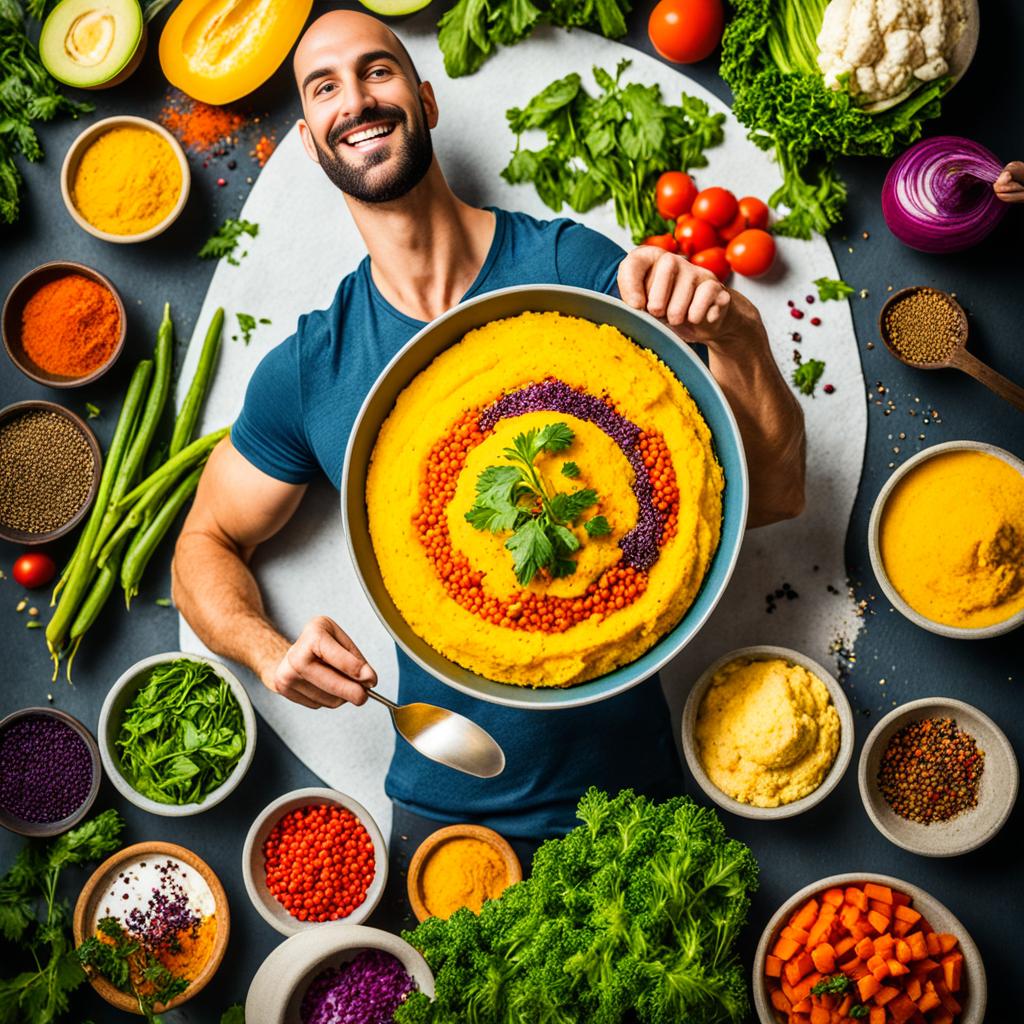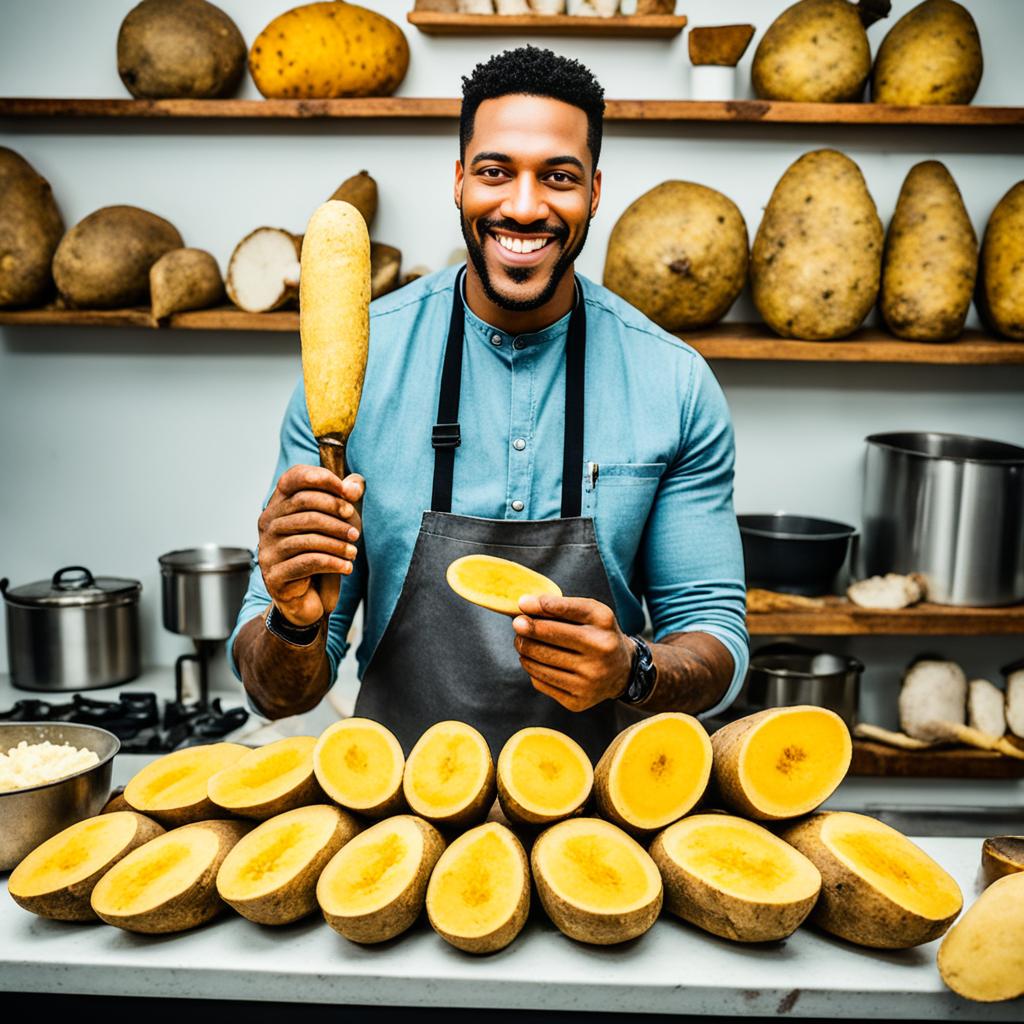Walking through Jamaica’s lively markets, you’re greeted by the smell of boiling yellow yams. This smell invites you to try this key Caribbean dish. For many generations, yellow yams have been a mainstay in Jamaican kitchens. They’re a big part of the island’s food culture.
Picture biting into a well-cooked yellow yam. Its softness and sweet taste are perfect with Jamaican dishes like ackee and saltfish, curry goat, curry chicken, and oxtail stew. The yellow yam adds a special flavor to these meals.
Boiling yellow yams is a tradition in many Jamaican families. Each family has its own way of doing it, like soaking the tubers or peeling them carefully. This shows how much Jamaicans value this simple yet amazing ingredient.
What Is Jamaican Yellow Yam?
Jamaican yellow yam, also known as Guinea yam, comes from Africa and was brought to the Caribbean by slaves. It’s a key part of Jamaican food and culture. People often eat it as a main dish with traditional meals.
Origins and Cultural Significance
This vegetable has roots in Africa, where it was a main food for a long time. Slaves brought it to the Caribbean, making it a big part of Jamaican food and culture. Now, it’s called a “ground provision” in Jamaica, meaning it’s a boiled root vegetable that’s very important to the island’s food history.
Yellow Yam vs. Sweet Potato
Unlike sweet potatoes, Jamaican yellow yams are drier and starchier with a mild taste. They go well with savory and spicy foods. While both are root veggies, they’re from different families. Yellow yams are in the yam family, while sweet potatoes are from the morning glory family. This is why what Americans call “yams” are actually sweet potatoes.
Nutritional Benefits of Jamaica Yellow Yam
Jamaica yellow yam is a nutritional powerhouse. It’s full of vitamins, minerals, and antioxidants. It has a lot of copper, which is important for making red blood cells and absorbing iron. Eating four ounces of cooked yellow yam gives you 816 milligrams of potassium. This helps keep your heart and muscles healthy.
Yellow yam is also high in dietary fiber, giving you about four grams in four ounces. Fiber is good for your digestion, helps control blood sugar, and can help with weight management. Plus, it’s low in calories, with only 80 to 100 kilocalories per four-ounce serving.
This yam is full of antioxidants like vitamin C and beta-carotene. These help protect your cells from damage and lower the risk of chronic diseases. Vitamin C also boosts your immune system by making more white blood cells.
If you want to increase your energy or improve your health, add Jamaican yellow yam to your meals. It’s packed with vitamins, minerals, fiber, and antioxidants. This Caribbean food is a superfood that should be in every kitchen.
Culinary Versatility: Incorporating Yellow Yam into Your Dishes
Jamaican yellow yam is great for both home cooks and chefs. It’s a versatile starchy root that can be used in many dishes. You can make traditional Jamaican recipes or try new fusion dishes with it.
Traditional Jamaican Recipes
In Jamaican cooking, yellow yam is often boiled, fried, or added to dishes like rice and peas. It also goes well in stews and soups. The mild taste of the yam blends well with Jamaican spices, making the flavors balance perfectly.
Modern Twists and Fusion Dishes
Yellow yam is also perfect for modern dishes. It can be used in curries, casseroles, and even baked goods. This adds a unique texture and a bit of sweetness. Chefs and cooks love to mix Caribbean flavors with global tastes to create new dishes.

Jamaica Yellow Yam: A Taste of the Tropics
Experience the vibrant tastes of the Caribbean with Jamaican yellow yam. This tuber is a delight, taking you to sunny island landscapes. It has an earthy, slightly sweet taste and a firm texture. This makes it great for traditional Jamaican dishes and modern recipes.
Jamaican yellow yam stands out from sweet potatoes with its savory taste. It’s perfect for bold spices and seasonings. Enjoy it alone or in stews, curries, or roasted dishes for a true Caribbean flavor.
The yellow yam is also packed with nutrients. It’s full of fiber, vitamins, and minerals. These nutrients support brain function and boost immune health. Adding Jamaican yellow yam to your meals is a tasty way to enjoy Caribbean flavors and culture.
Where to Find Fresh Jamaica Yellow Yam
If you’re looking for the real taste of Jamaica, you’re in luck. You can find fresh Jamaican yellow yams at your local grocery stores. These tubers are key in Caribbean cooking and are getting more popular in the U.S.
Local Markets and Grocery Stores
Caribbean grocery stores and international markets are great for buying Jamaican yellow yams. They offer a wide range of tropical produce, including this special yam. Big supermarkets like Walmart might also have them, but the choice and quality can change.
For the best selection and freshest yams, go to your local Caribbean or Latin American markets. These stores get their produce straight from the islands. This means you get the real taste and texture you want. Some online shops sell Jamaican yellow yams too. But, make sure to check shipping rules and order quickly for the best freshness.
Preparing and Storing Jamaica Yellow Yam
Preparing Jamaica yellow yam is easy. First, wash and peel the tuber. Then, chop, cube, or slice it as you like. This root vegetable fits well in many dishes, from traditional Jamaican to modern fusion.
For storage, keep the yam in a cool, dry spot, like potatoes. If you want to keep it longer, peel, chop, and freeze it in airtight bags or containers. Freezing Jamaica yellow yam keeps it fresh for up to 3 months, keeping its unique flavor and texture.
To enjoy Jamaica yellow yam all year, follow the best storage and preparation tips. This way, you can savor its delicious taste in both traditional and new dishes.

Jamaican Yellow Yam Stew: A Comforting One-Pot Wonder
Discover the vibrant tastes of the Caribbean with this hearty Jamaican yellow yam stew. It’s a true comfort food that highlights the versatility of the beloved yellow yam. Cooked in a coconut milk broth with aromatic spices, it’s a tasty way to enjoy this nutritious root vegetable.
Recipe and Cooking Instructions
To make this stew, start by simmering yellow yam chunks in a flavorful broth. Coconut milk makes the dish rich and creamy. Onions, garlic, bell peppers, thyme, and paprika add lots of flavor. A Scotch bonnet pepper gives it a subtle kick.
When the yam is tender, add fresh spinach leaves. They add color and nutrition to the stew. Let the flavors blend together for a fulfilling meal. Serve it hot with sides like boiled dumplings or steamed cabbage for a complete meal.
This stew is a great way to enjoy Caribbean flavors. It combines tropical tastes and healthy ingredients into one dish. It’s sure to become a favorite in your household.
Exploring Other Caribbean Root Vegetables
The Jamaica yellow yam is a key ingredient in Caribbean cooking. But it’s not the only root vegetable in the region. Discover the variety of tropical produce that makes Caribbean food so rich and varied.
Dasheen (taro) and sweet green bananas are just a few examples of the many root vegetables in the Caribbean. Each one has its own taste and uses in cooking. These tubers let cooks explore the rich produce of the Caribbean.
There’s more than just yam in the Caribbean. You’ll find malanga, yuca (cassava), and sweet potatoes, each with its own special traits. Malanga comes in three types – Malanga Blanca, Malanga Lila, and Malanga Amarilla – each with its own look and taste.
Taro is another starchy root vegetable with two main types: Eddoes and Dasheen. Eddoes are moist and soak up flavors well, while Dasheen is drier and crumblier after cooking. Yuca, or cassava, is loved in Latin America and Africa for its mild, slightly nutty taste.
Discover the wide range of other Caribbean root vegetables. From the earthy malanga to the versatile yuca, these tubers bring depth, texture, and nutrition to Caribbean dishes.
Conclusion
The Jamaican yellow yam is a key ingredient in Caribbean cooking. It’s loved for its taste and nutritional value. It’s grown a lot and is popular in Jamaica and around the world.
Adding the yellow yam to traditional Jamaican dishes or trying new recipes is exciting. Its flavor and texture are unique. Plus, it’s good for you, with health benefits like fighting cancer cells.
We recommend trying the Jamaican yellow yam if you like Caribbean food. It’s a way to enjoy the flavors of the tropics and support Jamaican culture.
